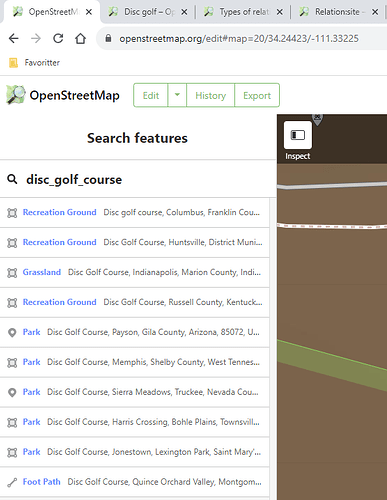Relevant link: Disc golf - OpenStreetMap Wiki
In this post, I would like to discuss how to map a Disc Golf Course (DGC). I have given this some thought, and feel like I have a sensible proposal for do’s and dont’s. The goal is to reach some consensus on how to map DGCs, and put that information into the linked OSM wiki entry for Disc Golf. The format is stating how I think it should be, and providing a reasoning after each point (in drop down to facilitate an overview of the proposal).
My proposal, with relevant discussion:
1) Add a node to represent the course, not an area. Tag the node with leisure=disc_golf_course and sport=disc_golf. Place the node at the course map if one is available, and next to the first tee if not.
Reasoning
The area of a DGC is ill defined. The well defined points of a DGC are the tees, hole (reccomended disc flight path), and baskets. These are all tagged with disc_golf=*. The true area of a DGC would be the area in which discs typically land, which is extremely hard to define, and could overlap with buildings, water, and other areas.Furthermore, the area is often part of a park or other area, meaning that the entire DGC area would overlap with an existing area, which is not ideal.
I therefore feel it is most sensible to tag the area as a node. The node should be placed near the start of the course to make the map data useful, as this is the point anyone wishing to use the course would navigate to.
2) The node should be named in the format “NAME Disc Golf”, where “NAME” should be consistent with the local part of the name of the given course in the UDisc app (if one exists). If there is no UDisc entry for the course, use the name of the local area.
Reasoning
Including "Course" at the end of the name would make the names very long. It would also be redundant information (with the `disc_golf_course` tag added).“Disc Golf” should be included in the name tag, as “NAME” is typically the name of the local area, and would be confusing on it’s own.
A space should be included between Disc and Golf (Common misspelling. I decided which one is correct based on the title of the wikipedia page, and the fact that “discgolf” returns about 33 million google hits, versus the about 78 million of “disc golf”).
Finally, “Disc Golf” is quite international and simple, and is easy to understand for just about anyone interested in the sport. This makes it well-suited for being part of the reccomended name-template.
3) If the tees, holes and baskets are mapped, these should be put into a relation together with the leasure=disc_golf_course node, using a type=site relation. The name of the relation should be identical to the node, with " Park" appended.
Reasoning
Relation type "site" is defined as "A site relation is used to group several objects which together have a single identity as a whole but cannot be accurately described by other data types.". This feels perfect for a disc golf course, meaning that an appropriate relation can be added without introducing a new relation type. There is also a `sport` relation, but I was unable to find documentation or usage of this tag, and "site" feels appropriate.The name could be consistent with the node because consistency is nice, and appending " Park" to the node name seems appropriate. It is also possible that if no guidelines exsist, many different relation name styles would be used, with a mix of local names, “Disc” “golf” and “park” with any combination of spacing, etc.
4) If available, add the udisc link as website=, the number of holes as disc_golf:course=, and par for a layout using all holes as disc_golf:par=. Par should be for the most commonly played layout (If unsure, prefer par for a layout that uses all holes exactly once).
Reasoning
A lot of additional and usefull information is available for most DGCs on UDisc's page. It is **THE** authorative source of DGC data. As it is something that most users would want, and should be easily accessable from the node.The number of holes and par for the course are easy to add, and important characteristics of the course. They should therefore be added. I do not know from where the latter two tags originated, but found them for most of my local disc golf courses.
Example
I have now mapped my local DGC in this manner, which may provide a useful point of discussion. I can not yet see it on openstreepmap.org, but it is added in this changeset.
I have also aligned Egeland Disc Golf Park to this style (see node and site relation)
Take a look, and see if you find it reasonable.
For context, the current results for disc_golf_course are a mess, with a mix of tags:
Important note on automating this task.
From the UDisc webpages, e.g. Øksnevad Frisbeegolfbane - Kleppe, Norway | UDisc Disc Golf Course Directory | UDisc, one can append /map to the url (Øksnevad Frisbeegolfbane - Course Map | UDisc Disc Golf Course Directory) to get an OSM map with the course details overlaid! This means that if someone buildt a tool/bot that scrapes this data and adds it to OSM, all courses can be perfectly mapped, possibly even with the leisure=disc_golf_course at the physical course map/next to tee 1. I believe the UDisc data is used to produce the physical printed maps, meaning that using that data would result in perfect consistency. Perhaps this could/should be done in collaboration with UDisc.
